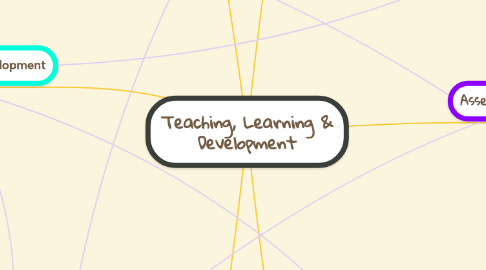
1. Students Body
1.1. Equality & Inclusiveness
1.1.1. Developmental Differences person-first langauge
1.1.1.1. Physical
1.1.1.1.1. Intro/Inter-individual rates of progression
1.1.1.2. Learning Disorders
1.1.1.3. Exceptionalities
1.1.1.3.1. High-incidence exceptionalities
1.1.1.3.2. Low-incident exceptionalities
1.1.1.4. Individualized Education Plan
1.1.2. Socio-Cultural Perspectives
1.1.2.1. Danger of a single Story
1.1.2.1.1. Inclusion of communities
2. Student Development
2.1. Cognitive
2.1.1. Growth mindset
2.1.1.1. Desire to learn
2.1.1.1.1. Embrace challenges
2.1.1.1.2. Learn from criticism
2.1.2. Student-regulated learning
2.1.2.1. Metacognition
2.1.2.1.1. Thinking about thinking
2.1.2.2. Motivational decisions
2.1.2.2.1. Interests
2.1.2.2.2. Innate curiosity
2.1.2.3. Strategic decisions
2.1.2.3.1. Relevancy
2.2. Personal
2.2.1. Maslow
3. Learning Theory
3.1. Cognitive approach
3.1.1. Mental processes
3.1.1.1. How People Learn Framework
3.1.1.1.1. Based on mini theories
3.1.1.2. Select-Organize-Integrate
3.1.1.3. Intelligence as structures
3.1.1.3.1. Gardner’s multiple intelligences
3.1.1.4. Intelligence as Process
3.1.1.4.1. Sternberg’s Triarchic Theory of Intelligence p. 197
3.2. Constructivist approach
3.2.1. Constructing one knowledge & understanding
3.2.1.1. Vytgotsky
3.2.1.1.1. Zone of Proximal Development
3.2.1.1.2. Scaffolding
3.3. Behaviourist approach
3.3.1. Behaviour is learnt & shaped by the environment
3.3.1.1. Thorndike
3.3.1.1.1. Observable behaviours
3.3.1.1.2. Science-will-cure-all
4. Teacher Planning
4.1. Curriculum
4.1.1. Educational purpose
4.1.1.1. Social needs and expectations
4.1.1.2. Research
4.1.1.2.1. Foundational Frameworks
4.1.1.3. Learning standards
4.1.1.3.1. Curriculum expectations
4.1.1.4. Discrete objectives
4.1.1.4.1. Learning goals
4.1.2. Learning experiences
4.1.2.1. Information
4.1.2.1.1. Demonstrations
4.2. Instructional
4.2.1. Student-centred approach
4.2.1.1. Universal Design for Learning
4.2.1.2. Differentiated instruction
4.2.2. Teacher-centred approach
4.2.2.1. Direct Instruction
4.2.2.1.1. 3-part lesson plan
4.3. Evaluation
4.3.1. Understanding by Design
4.3.1.1. Backward Design
4.3.1.1.1. Common Thread of Learning Objectives
5. Assessment
5.1. Diagnostic
5.1.1. Prior knowledge
5.1.1.1. Informs instructional starting point
5.2. Formative
5.2.1. During instruction
5.2.1.1. Multiple
5.2.1.1.1. Opportunities
5.2.1.1.2. Ways
5.3. Summative
5.3.1. After instruction
5.3.1.1. Learned material?
5.3.1.1.1. Yes
5.3.1.1.2. No
6. Dynamic Classroom Management
6.1. Classroom discourse research
6.1.1. Student-teacher discourse
6.1.1.1. Proactive
6.1.1.2. Exploratory
6.1.2. Explicit expectations
6.1.2.1. Reminder mechanisms
6.1.3. Routines
6.1.3.1. Consistency
6.2. Self-regulated behaviour
6.2.1. Reflecting on behaviour
6.2.1.1. Meaning of
6.2.1.1.1. Choice
6.2.1.1.2. Outcome

